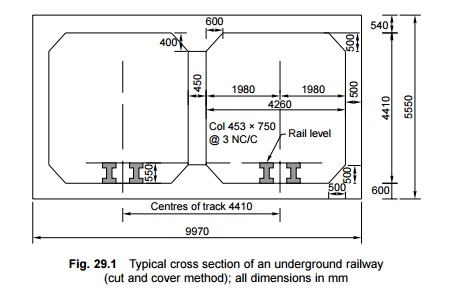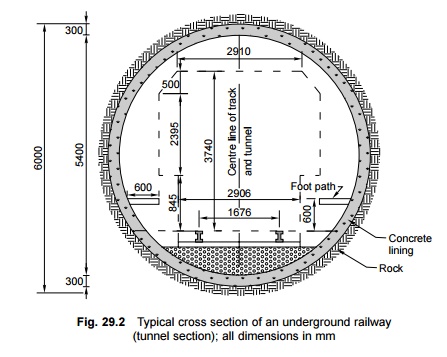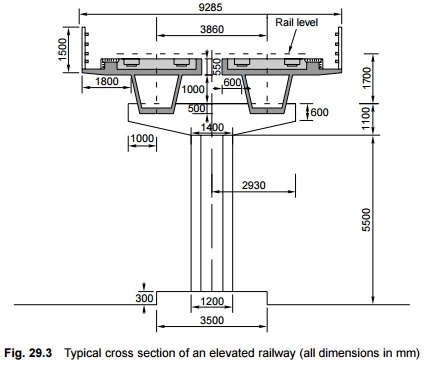Chapter: Civil : Railway Airport Harbour Engineering : Railway Engineering : Suburban Railways in Metro Cities
Urban Transport
Urban
Transport
The basic objective of urban transport is to provide
residences with access to activity such as workplaces, schools, shopping
centres, etc. The different forms of urban transport in use in most cities of
the world are the following.
(a) Motorbuses
(b) Trolley buses
(c) Tramways
(d) Surface
railways
(e) Underground
railways
(f) Elevated
railways
(g) Monorails
(h) Tube
railways
1. Motorbuses
This is the most convenient form of transport and is used
extensively in metropolitan cities. These buses run mostly on diesel oil and their
exhaust emissions have an adverse effect on the environment. Moreover, these
buses, though very convenient for transporting passengers, have very limited
seating capacity.
2
Trolley Buses
These are buses that derive their
energy through overhead electric transmission. Trolley buses are superior to
motorbuses as they do not pollute the environment. On the other hand, huge
expenses are incurred in providing overhead traction for supplying power to
these buses.
3 Tramways
Tramways require a track on which
the trams can run and as such require the infrastructure of a proper railway
track. Their initial cost is quite high. They cause minimal air pollution;
however, they contribute significantly to noise pollution. Tramways are almost
obsolete now and are used only in some parts of the country such as in Kolkata.
4 Surface Railways
Surface railways are the cheapest
and most extensively used form of railway service in the world. In such a
system, the track is laid on a ground that has a suitable embankment or
cutting, depending upon the topography of the area. Metropolitan railways use
electric traction because of the following advantages.
(a) Electric
traction does not pollute the environment.
(b) The
acceleration and deceleration of trains is faster.
(c) Electric
traction ensures the availability of power for improved and modern signalling.
(d) An
electric locomotive can haul a train with the same efficiency in both the
directions and there is no need for reversing the direction of the locomotive.
(e) This
system uses special type of coaches called electric multiple units (EMUs),
which can carry more traffic than conventional coaches.
Cost considerations
The construction of surface
railways with an overhead electric transmission system is quite costly and
comes to about Rs 10 to 15 million per km (excluding the cost of the land) in
normal terrain. The cost, however, increases considerably in dense and thickly
populated areas, where the cost of the land to be acquired is quite steep. In
addition, the railway line may have to be constructed across roads, some of
which may be quite busy.
Type of crossings
The points where the roadways and
the railways cross each other are provided with a level crossing, a road under
bridge, or a road over bridge, depending upon the volume of traffic being
carried by rail or road, availability of financial resources, road level
vis-à-vis rail level, proximity of land, and other allied factors. The special
characteristics of each one of these crossings are given in subsequent
paragraphs.
Level crossing At this
crossing, the railway track and the road cross each other at the same
level. In urban areas, most level crossings are manned by two to three watchmen
who are responsible for operating the same. Normally the level crossing remains
closed to road traffic and is opened only when road vehicles need to cross to
the other side. Though quite cheap and convenient, level crossings have the
following limitations.
Gatemen have to be provided for
manning level crossings, which proves to be quite costly.
(b) Level
crossings cause delay in the movement of road traffic, particularly when trains
are crossing them.
(c) Level
crossings pose a significant safety hazard and the number of accidents at level
crossings is quite substantial.
Road-over-bridge The road
over bridge is a kind of bridge where the road passes over the railway
line. It is an improvement over the level crossing and overcomes most of the
limitations of a level crossing are. However, the road over bridge has certain
limitations, which are as follows.
(a) The
road-over-bridge is a costly arrangement, as apart from the cost of
construction of the main bridge, heavy expenditure is involved in constructing
the road approaches and acquiring land.
(b) The
length of the detour provided for crossing the track is considerable,
particularly for cyclists and pedestrians. In some sections, therefore, a foot
over bridge is provided so that at least pedestrians and cyclists can use it to
cross the track.
Road-under-bridge In this
instance, the road passes under the railway line. A road-under-bridge is
preferred in places where the general ground level is low and the railway line
is at a comparatively higher level. A road under bridge is also preferred in
areas where enough land is not available. Normally, a road under bridge costs
less, but its construction is quite complicated. The cost may also increase if
excavation is required in rocky areas. If the water table is high, there may be
an additional cost involved for lowering the water table. A road under bridge
normally presents drainage problems, particularly during monsoons.
5 Underground Railways
In such a system, the railway
line is constructed below the ground level. The requisite construction work is
done mostly by the 'cut and cover method'. The area is excavated in the shape
of trenches and once the formation is ready, the track is laid, the necessary
overhead structures are provided, and finally the trenches are covered and the
ground is restored to its original state.
An underground railway system
normally uses 'electric traction', as steam and diesel tractions produce smoke
and lead to the pollution of the environment, which in this case becomes
particularly hazardous since these railways are underground. Proper
arrangements are also made for the drainage of underground railways as the
low-lying areas in which they are constructed are likely to get flooded during
the rains. Such underground railways have been constructed in Kolkata and Delhi
and in other countries around the world.
The main
advantages and limitations of underground railways are as follows.
Advantages
(a) Trains
can run fast and unobstructed in an underground railway system as there are no
road crossings or other similar problems.
(b) As the
trains move at incredible speeds, underground railways can deal with a very
high concentration of human traffic.
(c) There is
no wastage of land and a large area of the city, which would have otherwise
been used for surface railways, remains available for other utilities.
(d) Provides
safety from aerial attacks, particularly during war.
Limitations
(a) The
underground railway system is a very costly arrangement and a heavy financial
backing is required. The cost may vary anywhere from Rs 30 million to 100
million per km, depending upon the geographical features and other conditions.
(b) Special
attention needs to be given to the drainage as well as proper ventilation of
underground railways.
(c) During
construction, the residents of the city are greatly inconvenienced as
excavation work is normally carried out throughout the city. The water supply,
electricity supply, and sewerage system of the city are also affected, as the
diversion of many of these services is required during the constructional
phase.
Cross section of an underground railway
An underground railway may have
either one of the following cross sections depending upon the method used in
its construction.
Cut and cover In this case, excavation
is done by the cut and cover method. This method affects all public
services such as water supply, sewerage mains and electric and telephone lines,
which have to be diverted or suspended temporarily. The typical cross section
of an underground railway constructed using the cut and cover method is given
in Fig. 29.1.

Tunnel section The tunnel for the
underground railway is dug very deep into the ground, much below the
level at which the ground is dug for water and sewerage mains and for telephone
and electric lines. The circular cross section of the tunnel is sometimes made
by the application of modern techniques that involve pushing a big pipe of an
adequate size through the ground. The necessary infrastructure is then provided
within this circular tunnel. The typical cross section of such an arrangement
is shown in Fig. 29.2.

6 Elevated Railways
This type of railway is provided
at an elevation above the ground level. The track is laid on a deck, which is
supported by steel or RCC columns. The platforms and even the station building
are provided at an elevation for the convenience of passengers. The typical
cross section of an elevated railway system is illustrated in Fig. 29.3. The
main advantage of elevated railways is that they do not require any separate
land. There is no interference with road traffic as roads can be provided
between the columns. Elevated railways, however, have the following
limitations.
(a) The cost
of constructing such a railway is very high.
(b) There is
heavy noise pollution because all its components are out in the open.
(c) In the
case of accidents on elevated railways, the loss of life and property is very
high.
7 Monorail
The monorail is a form of elevated railway that is
provided with only one rail on which trains run. The trains can be suspended on
the monorail as in Montreal, Canada, or can be mounted on pylons as in Tokyo,
Japan. The monorail system is recommended only in exceptional cases where
operating the conventional systems is difficult.

8 Tube Railways
In this rail system, the
underground railways are generally provided at a depth of more than 25 m. The
railway line is constructed in a tunnel that is circular or tubular. The main
reason for taking the railway so deep into the ground is to avoid it
interfering with the water supply mains, sewerage system, telephone lines, gas lines,
etc., which are normally located within 10 m of the natural ground. Some of the
salient features of the tube railway are given below.
(a) The
railway stations of the tube railway are generally cylindrical in shape.
(b) Only
electric traction is used for hauling trains in order to avoid smoke and the
resulting environmental pollution.
(c) For the
convenience of passengers, escalators are provided for accessing and existing
the stations.
(d) An
automatic signal is provided for the faster and effective movement of trains.
The trains stop automatically when the signal indicates impending danger. Human
error is thus avoided to the maximum possible extent.
(e) In order
to ensure the safety of passengers, it is essential that the doors of the
compartments are closed before the train can start. This is done by means of a
centrally operated switch installed in the driver's cabin.
(f) Automatic
ticket issuing machines are installed in the concourse in order to reduce the
need for manpower and to ascertain that tickets are issued speedily for the
convenience of passengers.
(g) Adequate
indication and warning boards are displayed at significant locations so that
the passengers have ready information regarding the timing of the trains and
the platform number for each train without making too many enquiries.
Superiority of rail transport over road
transport
Rail transport is becoming
increasingly popular all over the world as far as its relation to urban
transport is concerned. This is due to the following advantages that rail
transport has over a road transport system.
(a) Its passenger
carrying capacity per lane space is 10 times more than that of road transport.
(b) It is
less prone to accidents and, therefore, the loss of life is less as against the
frequent road accidents due to acute congestion on the roads that take a heavy
toll on life.
(c) It has an
inherent advantage in respect of reduced levels of air, noise, and other forms
of environmental pollution. It is free from smoke and dust, which cause serious
health problems.
(d) It
ensures energy conservation, as it is run on electricity, whereas road vehicles
depend on oil the world reserves of which are fast running out.
(e) It is
cheaper than road transport. The subsidy required for rail transport per
kilometre is less than that required for road transport.
Study of MRTS
It has been experienced the world
over that road transport alone cannot efficiently meet the needs of intra-urban
transport in the case of large cities. Rail-based mass transport has been found
necessary for keeping road congestion within acceptable limits. The need for a
rail-based mass rapid transport system for the four metropolitan cities of India,
namely, Delhi, Kolkata, Mumbai, and Chennai, was recognized in the early 1970s.
Accordingly, the Planning Commission set up MRTS study teams for each of the
four cities under the guidance of the Ministry of Railways. The study reports
were finalized in the mid-1970s. On account of the massive investments that
were required and the simultaneous paucity of funds, the project remained on
paper except for a corridor in Kolkata, which was taken up subsequently. For
various reasons, progress on the Kolkata project was slow and was commercially
operated for the first time in October 1984.
Related Topics